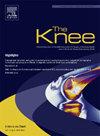全膝关节置换术中内侧一致负重会影响固定吗?一项随机对照试验。
IF 1.6
4区 医学
Q3 ORTHOPEDICS
引用次数: 0
摘要
背景:内侧一致(MC)轴承旨在促进全膝关节置换术(TKA)后内侧旋转,因为一致性提供了进一步的股骨内侧室约束。然而,这种设计差异可能改变关节内的力分布,潜在地影响胫骨植入物的固定。本研究的目的是比较MC与更传统的交叉保留(CR) TKA系统的迁移,用放射立体分析(RSA)测量。次要目的是比较两组患者感知的治疗结果和并发症的数量。方法:60例TKA患者随机分为MC或CR组,分别于3个月、1年和2年后随访。术后2年,主要终点是胫骨植入物的移动,通过基于模型的RSA测量最大总点运动(MTPM)。次要结果是胫骨MTPM,患者报告的结果测量值(PROMs)的变化和所有随访中记录的并发症数量。结果:52例患者获得主要结局(27例MC患者,25例CR患者)。我们发现MC组和CR组术后2年胫骨MTPM无差异。MC组和CR组的MTPM中位数(四分位间距)分别为0.60 (0.39-0.97)mm和0.48 (0.32-0.78)mm (P = 0.167)。两组间PROMs改善无差异,并发症数量无差异。结论:我们发现选择MC轴承与CR轴承相比,在TKA中胫骨内固定没有妥协。prom和并发症发生率表明两种类型的TKA轴承的治疗结果相当。本文章由计算机程序翻译,如有差异,请以英文原文为准。
Does a medial congruent bearing in total knee arthroplasty compromise fixation? A randomized controlled trial
Background
Medially congruent (MC) bearings aim at promoting medial pivoting after total knee arthroplasty (TKA), as the congruency provides further constraint for the medial femoral compartment. However, this design difference could alter intra-articular force distribution, potentially compromising fixation of the tibia implant. The aim of this study was to compare migration, measured with radiostereometric analysis (RSA), of an MC to a more traditional cruciate retaining (CR) TKA system. Secondary aims were to compare patient-perceived treatment outcome and number of complications between the treatment groups.
Methods
Sixty patients undergoing TKA were randomized to an MC or CR bearing and had follow up visits after 3 months, 1 and 2 years. Primary outcome was tibia implant migration, measured by maximal total point motion (MTPM) with model-based RSA, 2 years post-surgery. Secondary outcomes were tibia MTPM, change in patient-reported outcome measurements (PROMs) and number of complications registered at all follow up visits.
Results
Primary outcome was available for 52 patients (27 MC patients, 25 CR patients). We found no difference in tibia MTPM between the MC and CR groups 2 years post-surgery. Median (interquartile range) MTPM was 0.60 (0.39–0.97) mm and 0.48 (0.32–0.78) mm in the MC and CR group, respectively (P = 0.167). There were no between-group differences in improvement in PROMs and no between-group differences in number of complications.
Conclusion
We found no compromising of tibia implant fixation in TKA by choosing an MC bearing, when compared with a CR bearing. PROMs and complication rates suggest comparable treatment results with both types of bearings in TKA.
求助全文
通过发布文献求助,成功后即可免费获取论文全文。
去求助
来源期刊

Knee
医学-外科
CiteScore
3.80
自引率
5.30%
发文量
171
审稿时长
6 months
期刊介绍:
The Knee is an international journal publishing studies on the clinical treatment and fundamental biomechanical characteristics of this joint. The aim of the journal is to provide a vehicle relevant to surgeons, biomedical engineers, imaging specialists, materials scientists, rehabilitation personnel and all those with an interest in the knee.
The topics covered include, but are not limited to:
• Anatomy, physiology, morphology and biochemistry;
• Biomechanical studies;
• Advances in the development of prosthetic, orthotic and augmentation devices;
• Imaging and diagnostic techniques;
• Pathology;
• Trauma;
• Surgery;
• Rehabilitation.
 求助内容:
求助内容: 应助结果提醒方式:
应助结果提醒方式:


